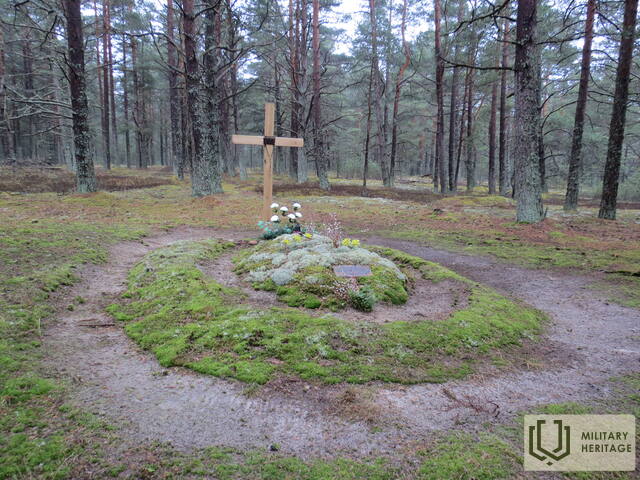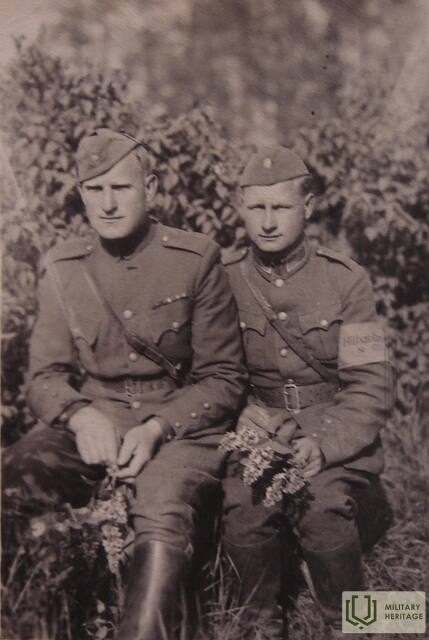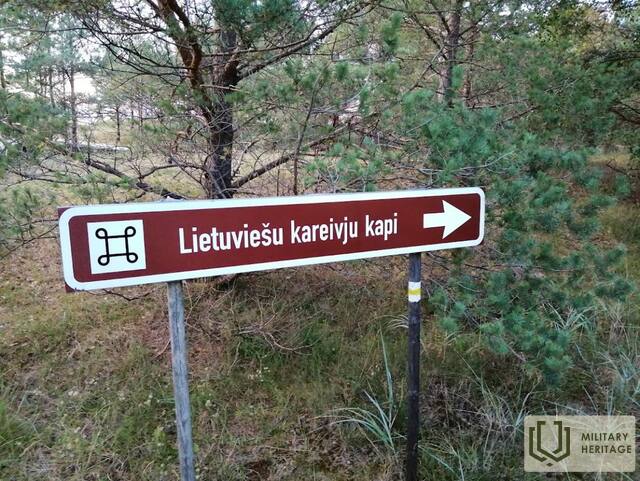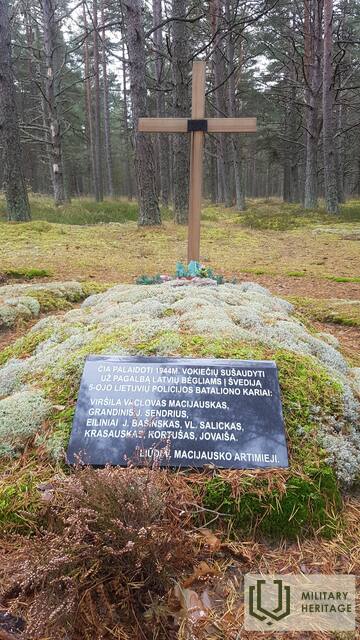Lithuanian soldiers' graves in Zaļkalns Forest
Memorial site


 215
215






The memorial is located near the Pāvilosta beach lookout tower in the dunes. There are signs pointing to the memorial.
At the end of the Second World War, three Lithuanian police battalions, the 5th, 13th and 256th, were also deployed in Latvia, and after guard duty and fighting against Soviet partisans and the Red Army on the Eastern Front, from autumn 1944 they were involved in guarding the Baltic Sea coast in Kurzeme.
In October 1944, all three battalions, consisting of 32 officers and about 900 instructors and soldiers, were subordinated to the German 18th Army's 583rd Rear Guard Unit (Koruck 583). The unit was tasked with guarding the Kurzeme coast from Liepāja to Ventspils. All three Lithuanian battalions were deployed in the vicinity of Pavilosta. In December 1944, the 13th Battalion was transferred to the German 1st Army Corps at the Liepaja Lake.
One of the tasks of the Lithuanian coastguard, besides being ready to fight enemy landings and to report enemy ships, was to prevent Latvian refugee boats from sailing to the island of Gotland, 160 kilometres away, but the Lithuanian coastguard men did not prevent the refugee boats from leaving. However, news of the Lithuanian coastguard helping the Latvian refugees and the Lithuanians themselves preparing to cross the sea to Sweden also reached the Germans.
On 10 January 1945, the soldiers of the 1st Company of the 5th Lithuanian Police Battalion were rounded up. More than a week of interrogation and trial followed, which, as a warning to the others, decided to execute seven of the Lithuanian soldiers and to imprison 11 of their comrades in concentration camps in Germany. The execution of the seven Lithuanian soldiers (Sergeant Macijauski, the company commander; Juozas Sendrjuas, a soldier; Vladas Salickas, a soldier; Ionas Bašinskis, Krasauskas and two unknown others) took place on 21 January 1945 in the Zaļkalns Pines in Pavilosta.
In January 1945, the 5th Battalion was disbanded and the combat-ready soldiers were divided into the two remaining battalions, while the rest were formed into a separate sapper company. At the time of the surrender of Army Group Kurzeme in May 1945, two battalions (13th and 256th) were still in Kurzeme as a sapper company with a total of 900 soldiers who were taken prisoner by the Soviets.
Used sources and references:
https://www.la.lv/lietuviesu-karaviru-drama-latvija
https://www.lsm.lv/raksts/dzive--stils/cilvekstasti/latvijas-klusie-varoni-lietuviesi-kas-nelika-skerslus-begliem-doties-pari-jurai-uz-gotlandi.a336877/
Related timeline
Related topics
Related stories
The first refugee boat "Centība" from Bambali
On 31 October 1944, the boat "Centība" left the Kurzeme coast. The departure of this boat was reconstructed by Valentīne Lasmane, the Convener of the Latvian Central Council, from the recollections of several fellow passengers
Compassionate Lithuanian Coastguard men
More than 70 years ago, Lithuanian coastguards were executed for helping their neighbours, Latvian boat refugees, to reach Sweden. When the German occupation authorities found out about this, they brutally
German army radar post in Jūrkalne
In order to protect the Kurzeme coast from a possible Soviet or even Western Allied attack, the German armed forces deployed radar stations in several locations, which allowed for a much earlier identification of enemy air activity. One of them was installed at Jūrkalne
Refugee boat transfer point from the Kurzeme coast to Sweden near the "Pāži" houses
One of the important places of relocation was near the “Pāži” house, where a monument has now been erected - “Sail of Hope”. “The ships came regularly and the most people left from “Pāži”, says the memories of I. Freibergs.







